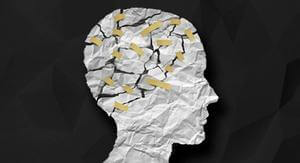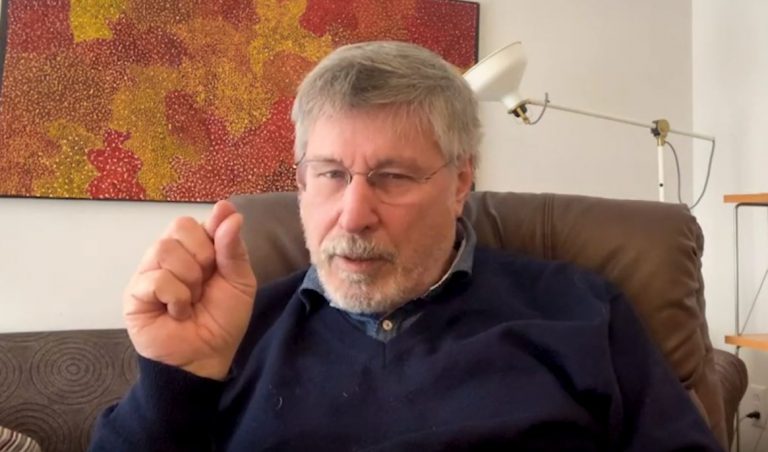NICABM Experts
Bessel van der Kolk, MD
Bessel van der Kolk, MD, is arguably the world’s leading expert in the treatment of trauma – especially when it comes to how trauma affects the brain, body, and nervous system.
Throughout his career, Bessel has been at the forefront of research on traumatic stress and the development of clinical therapies to treat it. He has pioneered approaches that focus on calming the nervous system, increasing self-regulation skills, and grounding patients in the present. In his research, Bessel has worked with a variety of clinical approaches, including neurofeedback, EMDR, psychodrama, and yoga.

So, what puts Bessel[1] at the forefront of trauma treatment and research? Throughout his career, he has brought forth a number of innovative and groundbreaking ideas to the field. Here are a few:
CE/CME Accredited Online Training Courses
You can check out a course with Bessel van der Kolk, MD, here:

How to Work with the Traumatized Brain
3 CE/CME Credits Available

The Treating Trauma Master Series
10 CE/CME Credits Available

Expert Strategies for Working with Traumatic Memory
2.75 CE/CME Credits Available

How to Work with the Limbic System to Reverse the Physiological Imprint of Trauma
3.25 CE/CME Credits Available
Talk Therapy Often Isn’t Enough to Heal Trauma
For many of us, talk therapy is a staple in our work. It’s a foundational part of Western psychology, and probably at the core of most of our formal education.
But according to Bessel, focusing on talk therapy might not be the most effective route to treating trauma. For one, trauma can be painful to talk about. Some clients might struggle to find the words to describe their experiences. In these cases, encouraging a client to open up might actually do more harm than good.
Even if a patient does feel comfortable sharing their trauma story, this doesn’t always mean that talking progresses treatment. While it may provide comfort or help make sense of a horrific event, it might also cause a patient to stagnate in their healing.
As Bessel puts it,
“At some point, the story often becomes an alibi. For many traumatized people, they tell the same story over and over again. Instead of feeling things very deeply, they go through a recital of misery, which is not the same thing as psychotherapy.”
– Bessel van der Kolk, MD, Treating Trauma Master Series
Now, this isn’t to say that talk therapy is entirely ineffective – Bessel acknowledges that. In fact, for some clients, verbalizing a past traumatic experience can be empowering – particularly if they’ve kept the trauma a secret for years.
But telling the story isn’t a cure-all – it’s just one piece of the puzzle. And while talk therapy might work with some clients, Bessel argues that there’s a better way to approach trauma treatment . . .
Knowing How to Work with the Body is Essential in Trauma Treatment
Bessel often says, “Trauma lives in the body.” In fact, one of his most well-known books, The Body Keeps the Score[2], centers on this idea.
But what exactly does he mean by this?
When a traumatic event occurs, it doesn’t simply rupture the parts of the brain that are involved in critical thinking and rationality. Rather, when a person senses danger, the lower parts of their brain – the parts responsible for our emotional impulses – light up. In other words, their most primal defenses kick in.
Often, these reflexive defenses are focused on protecting the body. That’s because if we think about our evolutionary history, most threats in ancient times were a matter of survival.
But here’s the thing – even though many modern-day traumas aren’t always about life or death, these areas of the brain still get activated. And even after the threat has passed, a person’s body still might be stuck in those primitive defensive states.
So what might this look like? You may have a client who is often restless, or perhaps one who’s frequently tense. Or maybe they seem disconnected from sensory experiences. Trauma can even lead to certain chronic illnesses, like back pain and digestive issues.
That’s why, whenever a client comes into Bessel’s office, he looks for these three physical signs:
- How do they walk into the room? – Posture can reveal a lot about a person’s mental well-being. Hunched shoulders and crossed arms might reflect high levels of shame. Likewise, if a client appears stiff or rigid, it may indicate that they’re stuck in a freeze response.
- Are they able to make eye contact? – For those who’ve experienced trauma, direct eye-contact can feel threatening. It can also be one of the many signs of shame.
- What do their breathing patterns look like? – Is a person taking rapid, shallow breaths? Are their breathing patterns irregular? Do they find it difficult to take long, slow, meditative breaths?
So, what does all this mean for our clinical work? For one, if a client’s body is still relying on those trauma defenses, trying to get through to them with just cognitive therapy might not do the trick.
Rather, Bessel says we we’d do well to target what drives a person’s sense of safety – that is, the nervous system.
How Does Trauma Affect Memory and Perception? A Look at the Limbic System . . .
According to Bessel, most of the therapies he advocates for are limbic system therapies.
Now that’s a bold statement to make. So what is it about limbic system therapies that makes Bessel endorse them so highly?
First, let’s do a quick run-down of the limbic system. You may already be familiar with it, but just to review . . .
Broadly speaking, the limbic system is involved in controlling the brain’s emotions. It contains both the hippocampus – which is responsible for memory formation – and the amygdala – which plays a role in detecting threats.
Let’s look at memory first. According to Bessel, what lies at the heart of traumatic memory is an inability to integrate context.
Here’s what that means: Unlike normal memories, traumatic memories fail to fit into a person’s understanding of reality.
Take this for example . . .
Say a trauma survivor has a flashback or a nightmare. Rather than recognizing that these are memories of the past, the person’s nervous system will interpret these sensations as threats in the present – it concludes that the trauma is happening all over again.
In Bessel’s words . . .
“A traumatic memory is fundamentally a breakdown of the ordinary memory system. An ordinary memory system can integrate things with everything else that you already know in the context of your existing reality. But trauma doesn’t fit in. Trauma cannot be integrated, and so it lives on as an isolated piece of the past that keeps coming back.”
– Bessel van der Kolk, MD, Expert Strategies for Working with Traumatic Memory
In essence, trauma keeps a person stuck in the past. Instead of simply remembering the event, the brain and body relive it.
That’s because trauma has the power to skew a person’s interpretations of reality. In fact, Bessel has identified these three ways that PTSD can alter a person’s perceptions:
- Enhanced threat detection system – People who have experienced trauma are often on high-alert for incoming danger. For example, take someone who grew up in an emotionally abusive household, often hearing the words “you’re not good enough.” As an adult, even slight criticism might send that person into a defensive state.
- Decreased ability to distinguish between an actual threat and a false alarm – This means a person might interpret threat where there actually is none. Consider a veteran with PTSD, for example. Something as ordinary as the sound of a car door slamming might send them right back into fight or flight mode.
- Diminished mind-body awareness – Trauma can disrupt a person’s ability to feel connected with their body. That’s because in many cases, “numbing out” to dangerous situations can actually be protective in the moment. However, this becomes a problem when, even after the threat has dissipated, a person stays stuck in this state.
To sum up, the role of the limbic system is to form memories and regulate perception. So it makes sense that, to undo the scars of trauma, we want to target the parts of the brain that learned, “the world is not safe for me.”
“A very important part of healing the trauma is to learn to activate your autonomic nervous system in a way that you can calm down your brain stem and your limbic system so you can get your frontal lobes online – it’s all bottom-up work.”
– Bessel van der Kolk, MD, How to Work with a Client’s Resistance
How to Integrate Somatic Therapy into Your Clinical Practice
So if you’re looking to integrate some body-based exercises into your practice, where might you begin? Over the years, Bessel has researched a number of innovative somatic interventions through his Trauma Research Foundation.[3] A few that Bessel advocates for include:
- Trauma-sensitive yoga
- Eye movement desensitization and reprocessing (EMDR)
- Theater & dramatic arts
- Rhythmic activities, like dancing or singing
The common factor behind all these therapies is that they’re experiential – they allow a person to feel a new way of being, rather than just imagine it. Such approaches, Bessel argues, offer more targeted ways to help clients release the remnants of trauma stored in the body.
As he puts it,
“I think some of the best therapy one can do is therapy that is very largely non-verbal where the main task of the therapist is to help people to feel what they feel—to notice what they notice, to see how things flow within themselves, and to reestablish their sense of time inside.”
– Bessel van der Kolk, MD, Advances in the Treatment of Trauma
And that can be key in helping clients make dramatic, more lasting shifts in their mental health.
References
You can check out a course with Bessel van der Kolk, MD, here:

How to Work with the Traumatized Brain
3 CE/CME Credits Available

The Treating Trauma Master Series
10 CE/CME Credits Available

Expert Strategies for Working with Traumatic Memory
2.75 CE/CME Credits Available

How to Work with the Limbic System to Reverse the Physiological Imprint of Trauma
3.25 CE/CME Credits Available
Find out more about Bessel van der Kolk’s approach to working with trauma here:

When the COVID-19 Pandemic Leaves Us Feeling Helpless
For most patients, the COVID-19 crisis has created a “new normal.”. . .

How Limbic System Therapy Can Help Resolve Trauma
Targeting the limbic system can make our interventions more effective. . .

3 Ways Undiagnosed Trauma Disrupts Lives
When people have trouble paying attention, when they’re too emotional . . .

Three Ways Trauma Changes the Brain
The treatment of trauma can be some of the most complex work practitioners face. . .